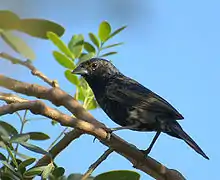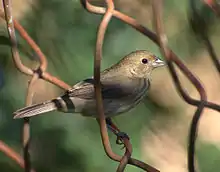Blue-black grassquit
The blue-black grassquit (Volatinia jacarina) is a small Neotropical bird in the tanager family, Thraupidae. It is the only member of the genus Volatinia. It is a common and widespread bird that breeds from southern Mexico through Central America, and South America as far as northern Chile, Argentina and Paraguay, and on Trinidad and Tobago.[2]
| Blue-black grassquit | |
|---|---|
 | |
| male at Manduri, São Paulo State, Brazil | |
 | |
| female at Manduri, São Paulo State, Brazil | |
| Scientific classification | |
| Kingdom: | Animalia |
| Phylum: | Chordata |
| Class: | Aves |
| Order: | Passeriformes |
| Family: | Thraupidae |
| Genus: | Volatinia L. Reichenbach, 1850 |
| Species: | V. jacarina |
| Binomial name | |
| Volatinia jacarina (Linnaeus, 1766) | |
 | |
| Synonyms | |
|
Tanagra jacarina Linnaeus, 1766 | |
This species is sexually dimorphic; the male is glossy blue with some white under the wing. The female is brown above and pale buff with darker streaks below.
Taxonomy
The blue-black grassquit was described by the Swedish naturalist Carl Linnaeus in 1766 in the twelfth edition of his Systema Naturae under the binomial name Tanagra jacarina.[3] Linnaeus based his description on the "Jacarni" that was described in 1648 by the German naturalist Georg Marcgrave in his Historia Naturalis Brasiliae.[4][5] The type locality is eastern Brazil.[5] The specific epithet jacarina is derived from the Tupi language and was used for a type of finch.[6] The blue-black grassquit is now the only species placed in the genus Volatinia that was introduced in 1850 by the German naturalist Ludwig Reichenbach.[7][8] The genus name is a diminutive of the Latin volatus meaning "flying".[9]
Within the tanager family Thraupidae the blue-black grassquit is in the subfamily Tachyphoninae and is a member of a clade that contains the genera Conothraupis and Creurgops.[10][11]
The blue-black grassquit was formerly placed with the buntings in the subfamily Emberizinae rather than with the tanagers in Thraupinae within an expanded family Emberizidae.[5][10]
Three subspecies are recognised:[8]
- V. j. splendens (Vieillot, 1817) – Mexico to Colombia and east through Venezuela and the Guianas to the Amazon basin; also Trinidad, Tobago and Grenada
- V. j. jacarina (Linnaeus, 1766) – southeast Peru to east Brazil and south to north Argentina
- V. j. peruviensis (Peale, 1849) – west Ecuador, west Peru and northwest Chile
Description
Adult blue-black grassquits are 10.2 cm (4.0 in) long and weigh 9.3 g (0.33 oz). They have a slender conical black bill. The male is glossy blue-black, with a black tail and wings; the white inner underwing is visible in flight or display. Female and immature birds have brown upperparts and dark-streaked buff underparts.
Behavior
Social monogamous, extra-pair fertilizations, intraspecific parasitism, and quasi-parasitism are commonly found.[12][13] During the breeding season, males defend small territories, about 13,0 - 72,5 m2, dominant males are normally lighter.[14] The male has a jumping display, often performed for long periods, which gives rise to the local name "johnny jump-up". This is accompanied by a persistent wheezing jweeee call,[15] jumping several times in a minute.[16] The extravagant display also has a cost of call attention of predator, thus displays increase the nest predation.[17] Predation are the main cause of breeding failure,[18] and predator vocalizations can cause immune-related reaction to this species.[19] Nests are small cups of rootlets (diameter about 7.5 cm) found at herbaceous vegetation 10–50 cm high,[20] clustered at landscape,[21] and placed preferably at high complex habitat spots.[22] Nests are built by both sexes.[18][23]
Blue-black grassquits will often form flocks when not breeding. They eat seeds, mostly on the ground.[24]
References
- BirdLife International (2012). "Volatinia jacarina". IUCN Red List of Threatened Species. 2012. Retrieved 26 November 2013.CS1 maint: ref=harv (link)
- "Blue-black Grassquit (Volatinia jacarina)". www.hbw.com. Retrieved 2018-05-14.
- Linnaeus, Carl (1766). Systema naturae : per regna tria natura, secundum classes, ordines, genera, species, cum characteribus, differentiis, synonymis, locis (in Latin). Volume 1, Part 1 (12th ed.). Holmiae (Stockholm): Laurentii Salvii. p. 314.
- Marcgrave, Georg (1648). Historia Naturalis Brasiliae (in Latin). Liber Quintus: Qui agit de Avibus. Lugdun and Batavorum (London and Leiden): Franciscum Hackium and Elzevirium. p. 210.
- Paynter, Raymond A. Jr, ed. (1970). Check-List of Birds of the World. Volume 13. Cambridge, Massachusetts: Museum of Comparative Zoology. p. 132.
- Jobling, James A. (2010). The Helm Dictionary of Scientific Bird Names. London: Christopher Helm. p. 210. ISBN 978-1-4081-2501-4.
- Reichenbach, Ludwig (1849). Avium Systema Naturale (in German). Volume Abt. 2 Bd. 1. Dresden and Leipzig: Friedrich Hofmeister. Plate LXXIX.
- Gill, Frank; Donsker, David; Rasmussen, Pamela, eds. (July 2020). "Tanagers and allies". IOC World Bird List Version 10.2. International Ornithologists' Union. Retrieved 26 October 2020.
- Jobling, James A. (2010). The Helm Dictionary of Scientific Bird Names. London: Christopher Helm. p. 404. ISBN 978-1-4081-2501-4.
- Burns, K.J.; Shultz, A.J.; Title, P.O.; Mason, N.A.; Barker, F.K.; Klicka, J.; Lanyon, S.M.; Lovette, I.J. (2014). "Phylogenetics and diversification of tanagers (Passeriformes: Thraupidae), the largest radiation of Neotropical songbirds". Molecular Phylogenetics and Evolution. 75: 41–77. doi:10.1016/j.ympev.2014.02.006.
- Burns, K.J.; Unitt, P.; Mason, N.A. (2016). "A genus-level classification of the family Thraupidae (Class Aves: Order Passeriformes)". Zootaxa. 4088 (3): 329–354. doi:10.11646/zootaxa.4088.3.2.
- Carvalho, Carlos B. V.; Macedo, Regina H.; Graves, Jefferson A. (2006-08-01). "Breeding strategies of a socially monogamous neotropical passerine: extra-pair fertilizations, behavior, and morphology". The Condor. 108 (3): 579–590. doi:10.1650/0010-5422(2006)108[579:BSOASM]2.0.CO;2. ISSN 0010-5422.
- Manica, Lilian T.; Graves, Jeff A.; Podos, Jeffrey; Macedo, Regina H. (2016-12-01). "Multimodal flight display of a neotropical songbird predicts social pairing but not extrapair mating success". Behavioral Ecology and Sociobiology. 70 (12): 2039–2052. doi:10.1007/s00265-016-2208-x. ISSN 0340-5443.
- Santos, Eduardo S.A.; Maia, Rafael; Macedo, Regina H. (2009). "Condition-dependent resource value affects male–male competition in the blue–black grassquit". Behavioral Ecology. 20 (3): 553–559. doi:10.1093/beheco/arp031. ISSN 1465-7279.
- Manica, Lilian T.; Macedo, Regina H.; Graves, Jeff A.; Podos, Jeffrey (2016-09-20). "Vigor and skill in the acrobatic mating displays of a Neotropical songbird". Behavioral Ecology. 28 (1): 164–173. doi:10.1093/beheco/arw143. ISSN 1045-2249.
- Carlos Biagolini-Jr. (2018-04-25), Tiziu - Blue-black Grassquit (Volatinia jacarina), retrieved 2018-05-14
- Dias, Raphael I.; Castilho, Leonardo; Macedo, Regina H. (2010-11-01). "Experimental Evidence that Sexual Displays are Costly for Nest Survival". Ethology. 116 (11): 1011–1019. doi:10.1111/j.1439-0310.2010.01817.x. ISSN 1439-0310.
- Carvalho, C. B. V.; Macedo, R. H. F.; Graves, J. A. (May 2007). "Reproduction of Blue-black Grassquits in central Brazil". Brazilian Journal of Biology. 67 (2): 275–281. doi:10.1590/S1519-69842007000200012. ISSN 1519-6984.
- Caetano, João V.O.; Maia, Maya R.; Manica, Lilian T.; MacEdo, Regina H. (2014-11-01). "Immune-related effects from predation risk in Neotropical blue-black grassquits (Volatinia jacarina)". Behavioural Processes. 109: 58–63. doi:10.1016/j.beproc.2014.07.003. ISSN 0376-6357. PMID 25038547.
- Almeida, Juliana B.; Macedo, Regina H. (2001-04-01). "Lek-like mating system of the monogamous blue-black grassquit". The Auk. 118 (2): 404–411. doi:10.1642/0004-8038(2001)118[0404:LLMSOT]2.0.CO;2. ISSN 0004-8038.
- Dias, Raphael Igor; Kuhlmann, Marcelo; Lourenço, Luciane R.; Macedo, Regina H. (2009-11-01). "Territorial Clustering in the Blue-Black Grassquit: Reproductive Strategy in Response to Habitat and Food Requirements?". The Condor. 111 (4): 706–714. doi:10.1525/cond.2009.090142. ISSN 0010-5422.
- Aguilar, Thais M.; Dias, Raphael I.; Oliveira, Ailton C.; Macedo, Regina H. (2008-03-01). "Nest‐site selection by Blue‐black Grassquits in a Neotropical savanna: do choices influence nest success?". Journal of Field Ornithology. 79 (1): 24–31. doi:10.1111/j.1557-9263.2008.00142.x. ISSN 1557-9263.
- Carlos Biagolini-Jr. (2018-04-25), Tiziu - Blue-black Grassquit (Volatinia jacarina), retrieved 2018-05-14
- Ridgely, Robert S.; Tudor, Guy (2009). Birds of South America: Passerines. Helm Field Guides. London: Christopher Helm. p. 630. ISBN 978-1-408-11342-4.
External links
| Wikimedia Commons has media related to Volatinia jacarina. |
- BirdLife species factsheet for Volatinia jacarina
- "Blue-black grassquit media". Internet Bird Collection.
- Blue-black grassquit photo gallery at VIREO (Drexel University)
- Blue-black grassquit species account at Neotropical Birds (Cornell Lab of Ornithology)
- Interactive range map of Volatinia jacarina at IUCN Red List maps
- Audio recordings of Blue-black grassquit on Xeno-canto.
